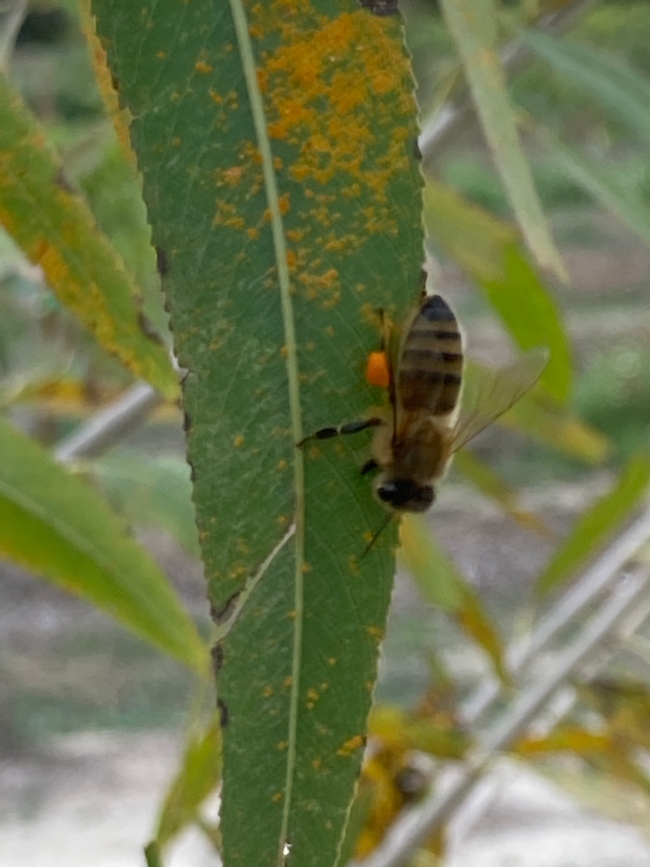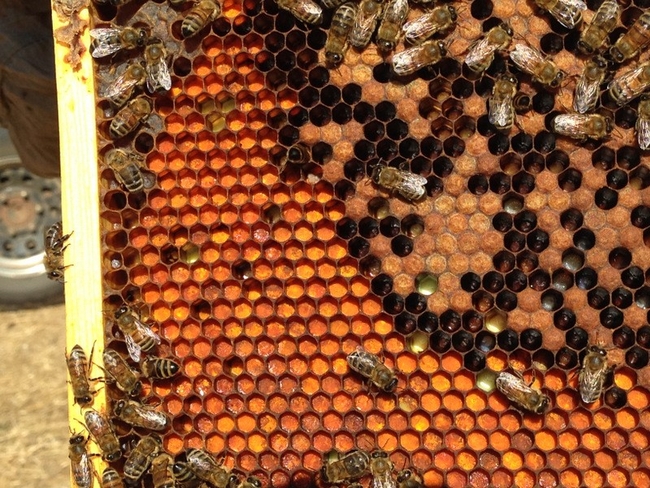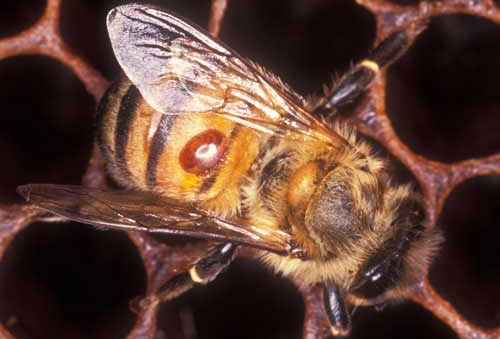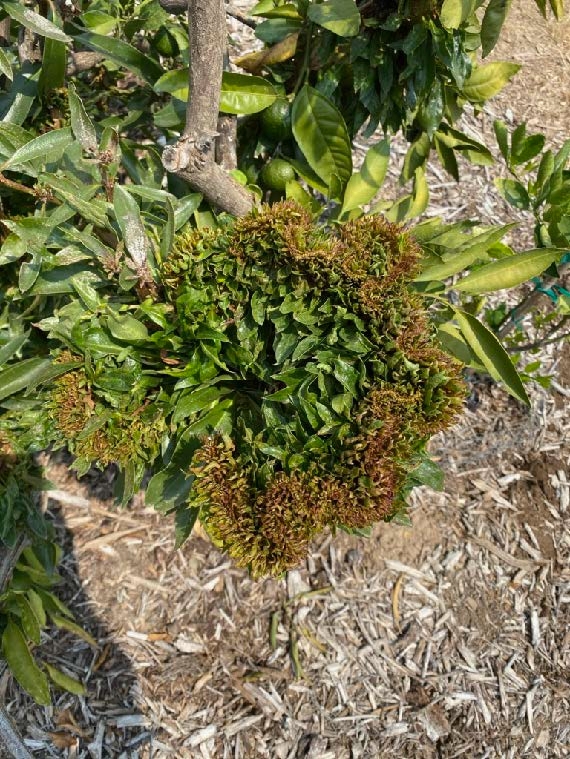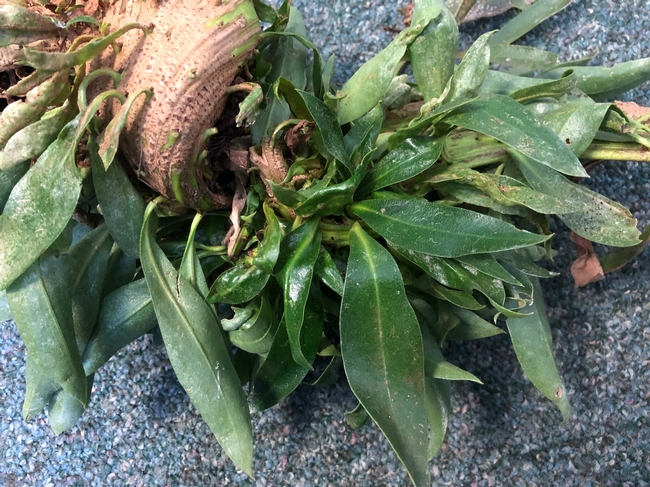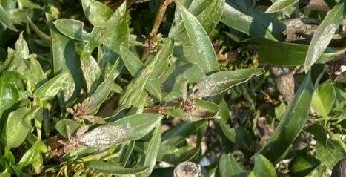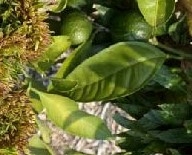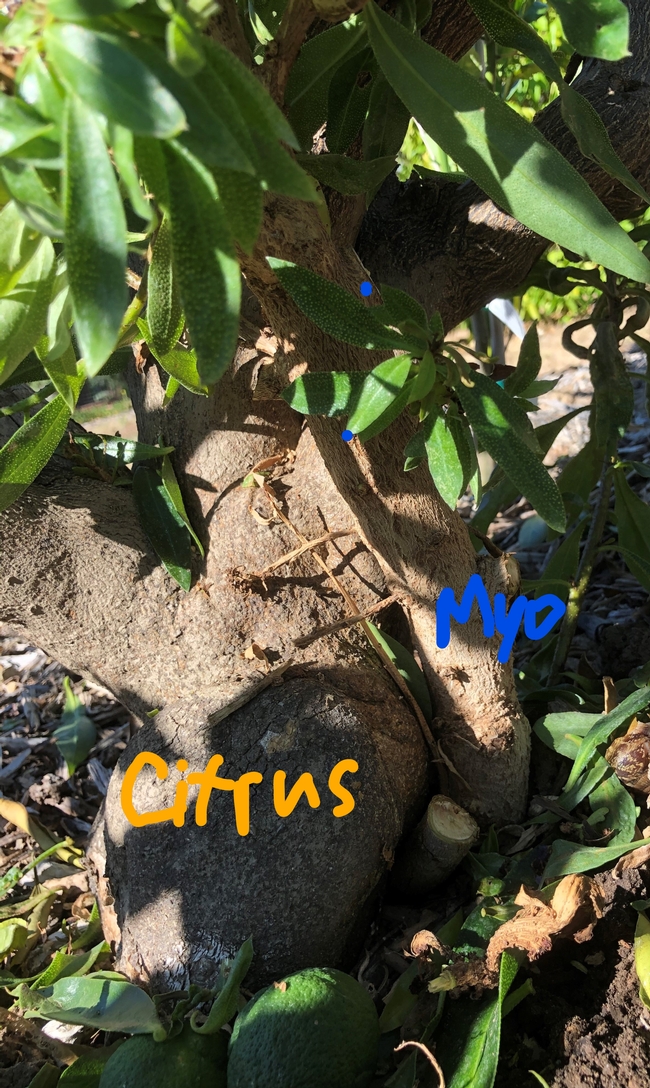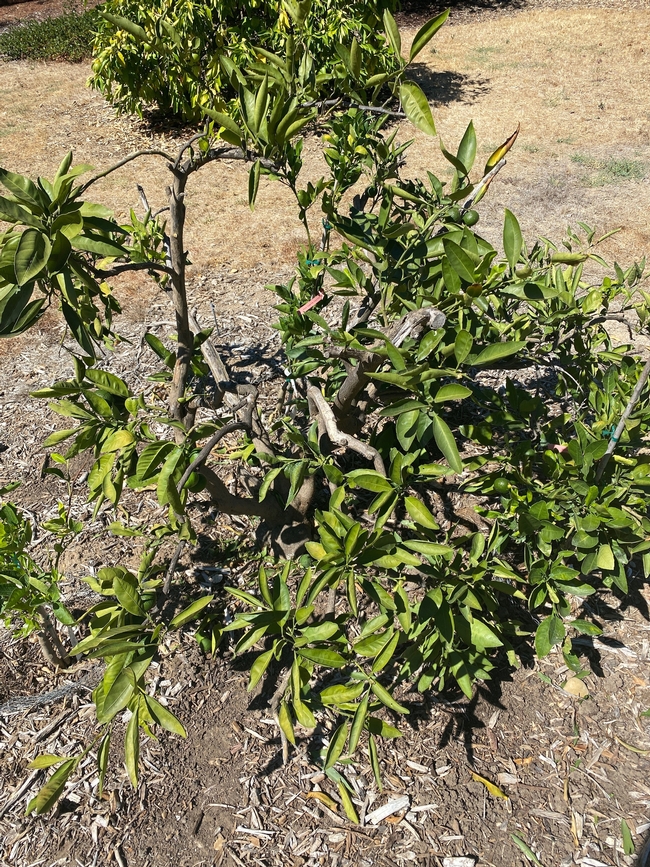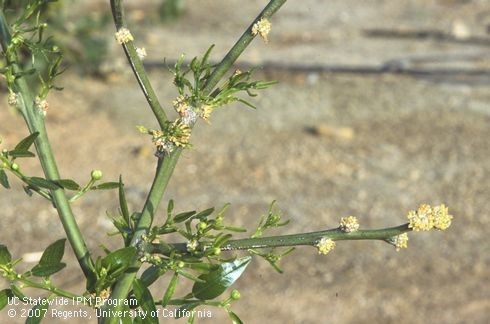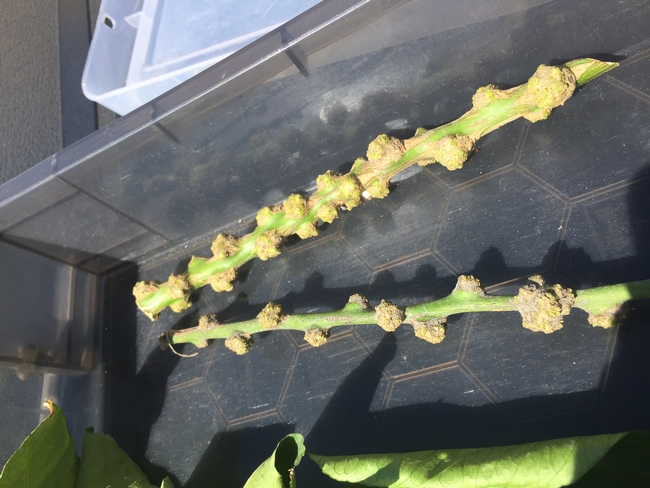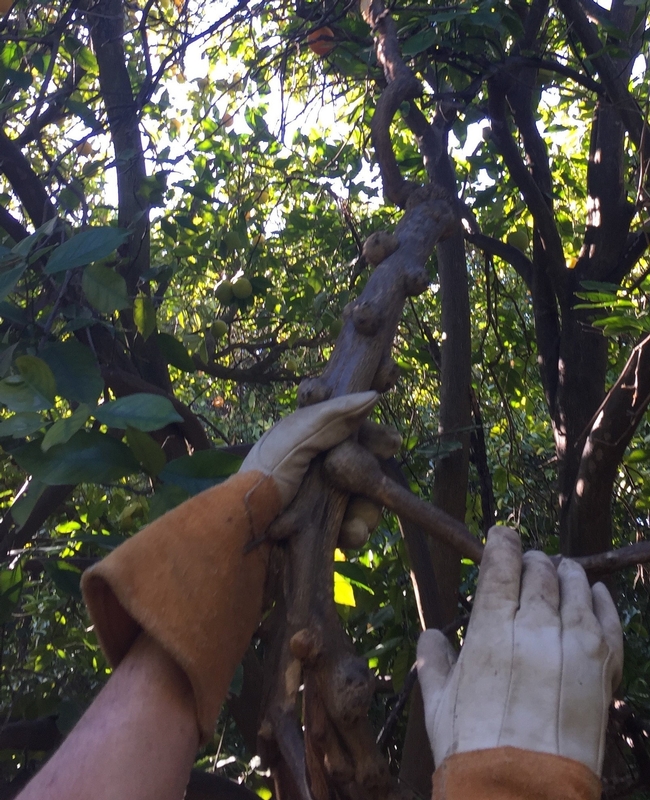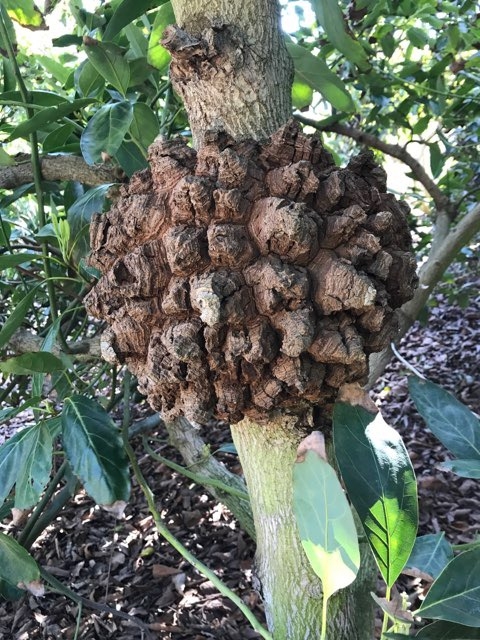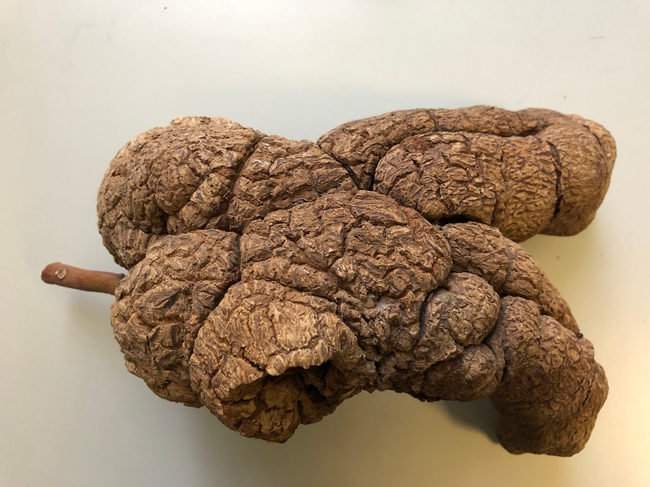
Posts Tagged: fungus
Fungus-eating Honeybees??????
Image: Allen King
A Fillmore grower recently reported honeybees collecting rust spores on willow trees!!! Her baskets are loaded with rust spores. Rust-collecting honeybees are reported by others so it's not an unusual occurrence.
From: Randy Oliver, “Fried Eggs” Identified! https://scientificbeekeeping.com/fried-eggs-identified/ Oliver shows bee-collected rust pollen from poplar trees in Spain in hive frames.
Quote: "Above is a photo of a typical comb filled with beebread consisting of rust fungus spores. Note the lousy brood pattern and the dying brood. When the colony is feeding upon this beebread, it goes downhill quickly. However, if we feed the hive several pounds of high-quality pollen sub, it will turn around immediately and grow again.
Antonio Pajuelo (pers comm) also reports a correlation between the consumption of poplar rust spores and colony mortality, but doesn't know whether it is due to spore toxicity or lack of better nutrition. It may be that the collection of rust spores is due to the lack of more attractive and nutritious floral pollen, and as such would simply be a generic indicator of poor colony nutritional status.
On the other hand, Schmidt (1987) found that caged bees fed Uromyces spores as a sole protein source actually had their lifespan reduced compared to those fed sugar syrup only—strongly suggesting that the spores were toxic. The spore-fed bees lived about 20 days less than those fed the most nutritious pollens!"
John Menge, a retired UC Riverside plant pathologist and mycologist has this reasoning:
The bee rust problem is very interesting.
I would have liked to work on that problem when I was at Riverside.
Two thoughts:
First I thought poplar rust was a Melampsora not Uromyces.
All the old literature gave the Uromyces name to all Uredospore stages.
Second, as you know, rusts have five different spore stages.
It would help to know what spore stages are in the hives.
One spore stage is pycniospores.
It is the spermatia stage and is sweet as honey.
It attracts all types of insects including bees.
Its job is to promote fertilization of the fungus so the bees are pollinating the fungus.
In the process of gathering the spermatia sugar, the bees are inadvertently gathering urediniospores.
Or perhaps there is lingering pycnia sugar on the urediniospores.
Or perhaps there are other attractants on the spore so the bees will disperse them.
At any rate I can tell the researchers are entomologists because they are worried about the bee colonies.
Mycologists worry about the cottonwood trees and the success of the rust fungi.
Apparently the fungi have outsmarted the insects again.
Fungus Helps a Honeybee
New fungus strain could provide a chemical-free method to help honey bees
Jennifer Han
jennifer.o.han@wsu.edu
PULLMAN, Wash. -- A new fungus strain could provide a chemical-free method for eradicating mites that kill honey bees, according to a study published this month in Scientific Reports.
A team led by Washington State University entomologists bred a strain of Metarhizium, a common fungus found in soils around the world, to work as a control agent against varroa mites. Unlike other strains of Metarhizium, the one created by the WSU research team can survive in the warm environments common in honey bee hives, which typically have a temperature of around 35 Celsius (or 95 F).
"We've known that metarhizium could kill mites, but it was expensive and didn't last long because the fungi died in the hive heat," said Steve Sheppard, professor in WSU's Department of Entomology and corresponding author on the paper. "Our team used directed evolution to develop a strain that survives at the higher temperatures. Plus, Jennifer took fungal spores from dead mites, selecting for virulence against varroa."
Jennifer Han, a post-doctoral researcher at WSU, led the breeding program along with WSU assistant research professors Nicholas Naeger and Brandon Hopkins. Paul Stamets, co-owner and founder of Olympia-based business Fungi Perfecti, also contributed to the paper. Stamets is a fungi expert, well-known for using several species in applications ranging from medicine to biocontrol.
Varroa destructor mites, small parasites that live on honey bees and suck their "blood," play a large role in Colony Collapse Disorder, which causes beekeepers to lose 30-50% of their hives each year. The mites feed on bees, weakening their immune systems and making them more susceptible to viruses.
The main tools beekeepers use to fight varroa are chemicals, such as miticides, but the tiny pests are starting to develop resistance to those treatments, Naeger said.
Metarhizium is like a mold, not a mushroom. When spores land on a varroa mite, they germinate, drill into the mite, and proliferate, killing it from the inside out. Bees have high immunity against the spores, making it a safe option for beekeepers.
Stamets, who did some of the initial testing with Metarhizium that showed the fungus couldn't survive hive temperatures, was impressed by the work done by the WSU researchers.
"Science progresses through trial and error, and my technique wasn't economical because of the hive heat," he said. "But Jennifer did enormous amounts of culture work to break through that thermal barrier with this new strain. It's difficult to really appreciate the Herculean effort it took to get this."
Han and Naeger screened more than 27,000 mites for levels of infection to get the new strain.
"It was two solid years of work, plus some preliminary effort," Han said. "We did real-world testing to make sure it would work in the field, not just in a lab."
This is the second major finding to come from WSU's research partnership with Stamets involving bees and fungi. The first involved using mycelium extract that reduced virus levels in honey bees.
"It's providing a real one-two punch, using two different fungi to help bees fight varroa," Stamets said. "The extracts help bee immune systems reduce virus counts while the Metarhizium is a potentially great mite biocontrol agent."
The next step is to seek approval from the Environmental Protection Agency to use Metarhizium on hives used in agriculture. The team must also finalize delivery methods for beekeepers to apply the fungus in hives.
"We hope in 10 years that, rather than chemical miticides, Metarhizium is widely used to control Varroa mites," Sheppard said. "And that the mite problem for beekeepers has been significantly reduced."
The team thinks the methods they developed to evolve Metarhizium for varroa control could be used to improve biocontrol agents in other crop systems as well.
A female Varroa destructor Anderson & Trueman, feeds on the hemolymph of a worker bee. The mite is the oval, orange spot on the bee's abdomen. Photograph by James Castner, University of Florida.
Sleuthing a New Devastating Disease
So Sphaeropsis tumefaciens causes galls, but it's also been noted to cause witches broom in citrus, as well. Thjs type of broom formation is a wild, though compact growth. It's a dense mass of shoot growth from a single point – a messy mass that even a witch would have a problem using to sweep up. This is a symptom of infection by certain fungi, like rust or mildew or a genetic mutation in the plant itself. If it's a stable genetic change that doesn't alter over time, it could be used in the horticultural trade to propagate dwarfing plants. That might be good in the case of citrus, meaning less pruning. There's already the ‘Flying Dragon' rootstock that causes dwarfing, but it has some problems, like being really slow growing.
Anyway, another cause of undisciplined broom growth is phytoplasma infection. These are bacteria-like organisms that were only discovered in the 1960s and cannot be cultured. This makes it hard to work with them. They can cause debilitating weaknesses in plants besides the broom growth. To complicate the culturing issue, it has a conspirator, which needs to be understood, as well. The phytoplasma is spread by an insect, the same way the Liberibacter bacteria is spread by Asian Citrus Psyllid, causing HLB. So it's necessary to know the biologies of two actors, plus how they interact. The problem of HLB, again.
In India and Iran, there is a crippling disease of lime caused by a phytoplasma that is spread by leafhoppers. You need the specific leafhopper to spread the phytoplasma to spread the disease. No leafhopper and it's unlikely that even if the phytoplasma were here, that it would get spread.
The internet is democratizing. It spreads all kinds of information equally to everyone. So an image comes across my computer, asking if I think the wild growth on the ‘Pixie' mandarin is this WBDL (Witches' Broom Disease of Lime). I don't think so, but you never know what is going to pop up. I was thinking it's probably Sphaeropsis on a new track, and whatever, need to check it out.
And there it is. The wild growth. It fills about a third of the canopy of the little tree.
There's even this flattened stem. Truly weird.
But something does not look right. Is it the phytoplasma causing other types of growth? The leaves don't look right. Citrus leaves have a central vein, with lateral veins. The leaves on the affected part of the tree only have a single mid-vein.
This is not a citrus growth deformity. This is some other plant. Following the stem of the deformed branch to the base of the trunk, there's the “sucker”. And it doesn't look like citrus bark.
This is not even a citrus plant. At some point, a myoporum seedling started growing there. The leaves are similar enough to citrus, that the grower thought it was a citrus branch than had become infected. Well, the myoporum did become ‘infected'. With what, I'm not sure. It could easily have been Sphaeropsis since it is in the Ojai area. Anyway, “when it doubt, cut it out”.
And here is the neat little tree, a third of it gone now and the interior exposed to sun so that it will need to be whitewashed to protect it from sun damage. But, it's not WBDL. This time. It's important to keep looking for what nature and hitchhikers can bring us. It could be a whole lot more serious.
Citrus Tree Gall
There are always new things to see in the field. Some things show up on occasion, but reliably, like citrus leafminer starts damaging new leaves in the fall. You start to see the leaf spots from Persea mite in the fall, even though they started their nesting/feeding activities in the late spring. Then some things show up irregularly. There's a fungus that hits citrus and other plant species – oleander, bottlebrush, holly, Natal plum, Brazilian pepper, eucalyptus – but mostly landscape species.
Sphaeropsis tumefaciens pops up here and there, this year and then not for several years. I've only seen it in Ojai, but Craig Kallsen in Kern Co. says that it's not uncommon in Bakersfield backyard citrus. It creates knobby growths, galls or tumors along branches. I've seen it on mandarin (‘Pixie'), lemon, Valencia and ‘Late Navel'. Whenever I see it, I immediately think of glyphosate damage.
A lot of times, you can see twisted leaf growth coming out of the galls. Classic herbicide phytotoxicity symptoms. But symptoms are just that, they don't tell you what caused that symptom to happen. In the several cases I've, seen only one out five has been an orchard that used herbicides. So it wasn't a reaction to glyphosate that caused the unusual growths.
These woody growths take several years to form. They don't show up just after an herbicide spray. It probably take a few years for them to show up. It's not until someone is pruning that they probably notice the galls.
In fact, it might be the pruning that is spreading the spores that causes the infection. Moisture helps spread the fungus. Another reason not to prune citrus during the rainy season.
While looking through the literature, I came across a reference to galls forming in avocado caused by Sphaeropsis – this in Mexico, http://www.avocadosource.com/WAC2/WAC2_p129.pdf. I have seen symptoms like that here
Also causing a whole fruit to form a gall. Truly a bizarre sight
But of course, this is my speculation, since these symptoms have not been tested foe their cause, as far as I know.
What causes the symptoms in Mexico might be different in California.
How to treat these galls in citrus? Cut them out if you can, but in many cases they are right in the middle of a structural branch. It is desirable to get it out of the orchard to prevent its spread. With the limited experience we have with this disease, it doesn't seem to impair yield at the levels of infection i have seen.
Read All About Citrus Diseases
|
|

citrus black spots

